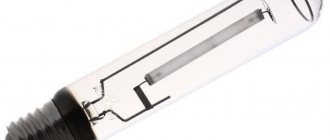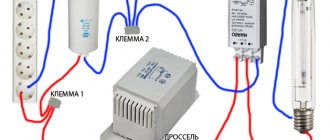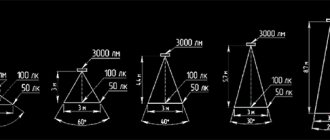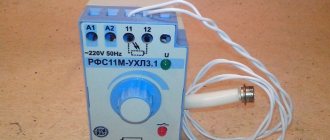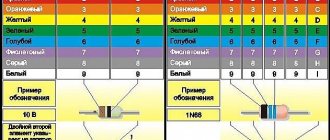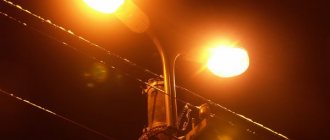Street lighting is one of the mandatory elements of improvement of residential areas, the procedure for which is regulated by the standards in force in the CIS. The main document defining the requirements for street lighting is SNiP 23-05-95. A number of industry standards that define lighting standards for alleys, roads, squares and park areas serve the same purposes. These departmental documents stipulate nuances regarding the lighting features of specific objects, including roads and entrances to buildings.
Basic requirements for street lighting
It is important to understand that outdoor lighting is completely different from indoor lighting, primarily in design. The technical data and, of course, the installation method are also different. When choosing street lighting lamps, you should take into account completely different priorities.
Firstly, when choosing street lights, there is no need to pay attention to color indicators, which are necessarily taken into account when choosing indoor lighting. In this case, the power or light output of the device is much more important. Secondly, it is important to consider the duration of operation, since replacing lamps is a process that requires a lot of time and effort. In addition to the above, replacing outdoor lighting often requires special equipment, so the duration of the work is an important criterion to consider when choosing.
For street lighting, lamps are equipped with certain lamps.
- Incandescent lamps: characterized by positive characteristics in terms of luminous flux power and low efficiency.
- Halogen: unlike the first ones, they have halogen gas inside the flask. This at least doubles the lifespan of this lamp.
- Gas discharge: they are used as a replacement for incandescent and halogen lamps.
Subtleties of choice
When choosing street lights, you need to consider the following criteria:
- climate features;
- influence of the external environment on the device;
- traffic intensity in the illuminated area;
- device installation feature;
- the desired brightness in the illuminated area.
Since street lighting lamps are constantly exposed to external factors, such as temperature changes, precipitation, moisture, lamps must have good insulation, so it is necessary to pay attention to the degree of protection (IP).
Optical systems of luminaires
The optical systems of outdoor lighting systems are mainly mirror and mirror-prismatic, while solid smooth, textured, corrugated and plate reflectors are common, as well as prefabricated reflectors consisting of a number of replaceable mirror inserts, as well as their combinations. In order to ensure the possibility of using high-pressure mercury lamps of various types in one optical system while maintaining the required luminous intensity curve, a number of designs of lighting devices provide for focusing by horizontal and vertical movement of the cartridge and fixing it in the desired position.
Prefabricated mirror reflectors, as a rule, consist of a bottom and mirror inserts. By changing the relative position and inclination of the inserts, the type and power of the light source, it is possible to obtain luminous intensity curves that ensure uniform distribution of the required brightness level on streets of various classes and geometries; To do this, a set of marked holes is usually made in the bottom, with the help of which the necessary installation and fastening of the mirror inserts is carried out.
Basically, high-tech outdoor lighting systems use independent reflectors, which makes them possible to remove, clean or replace. In lightweight, less material-intensive and cheaper designs of outdoor lighting systems, the functions of a housing and a reflector are often combined.
As a rule, the mirror-reflecting elements of the optical system of lighting devices are made of alzac or anodized chemically pure aluminum or metallized (most often aluminized by vacuum sputtering) steel parts. At the same time, in recent years, cast metallized polycarbonate has been increasingly used to produce elements of mirror optical systems, especially inserts.
The same material (as well as heat-resistant polymethyl methacrylate) is gradually replacing silicate glass for the manufacture of protective transparent textured light-transmitting elements, as well as refractors. The high impact resistance and heat resistance of protective elements made of polycarbonate, despite its lower light resistance and service life than polymethyl methacrylate, provide this material with a particularly wide range of applications specifically for outdoor lighting systems due to the need to ensure their high protection from mechanical shocks.
As a rule, protective elements made of polycarbonate and polymethyl methacrylate are not obtained from a sheet, but from a granular source material using injection molding methods. Hollow closed lenses and protective glasses (spherical, cubic, octahedral and other shapes) are produced by casting using special equipment.
Applications of street lamps
To illuminate the largest highways, devices with a reflector (a device for increasing the concentration of light) with a power of 250 to 400 W are usually used. If it is necessary to illuminate a secondary road, you can use special lampshades that scatter light on the roadway or, as in the previous case, a reflector. For such purposes, lamps with a power of 70–250 W are suitable.
On sidewalks intended for pedestrians, as well as in forests, parks and bicycle paths, predominantly diffused light is used. The power of the devices in this case is 40–125 W. The choice of power is made depending on the distance at which the pillars are located from each other.
Special spotlights are used to illuminate billboards, road signs, buildings and other information objects. Decorative lighting techniques are used to illuminate buildings.
Features and Specifications
LED lamps for outdoor lighting are characterized by at least two categories of parameters – structural and lighting technical. The former determine the characteristics of the elements from which they are composed, the latter - brightness, power, rated voltage and other important properties.
LED luminaires for outdoor installation include 4 unchanged components:
- Lamp.
- Driver.
- Reflector.
- Frame.
LED light bulbs for street lighting directly affect the lighting power of the entire device. The number and type of LEDs may also vary from one model to another. For example, this can be either a standard lamp with an E27 base or a separate board with semiconductor crystals.
Note! Many manufacturers produce LED lamps for street lighting without the ability to replace the lamp, due to their long service life. In addition, such models are cheaper than their base counterparts, but the light source in them, as a rule, is not replaced.
The power module is the most important component of LED street lamps. The life of the lamp and the quality of lighting will largely depend on the stability of the current supplied to the circuit. The main characteristic of the driver - power - must correspond to the total similar indicator of the ice elements in the flashlight.
The reflector concentrates and determines the direction of the light flux. The angle of illumination will vary depending on the focusing system design. This will determine the purpose and other lighting characteristics of the street lamp and its scope of application. Often, LED lamps are equipped with lenses, thus creating a diffused lighting system without the need to use a special device.
The housing serves to protect LED lamps from various outdoor factors. These include weather conditions, the actions of vandals and intruders, as well as external and internal overheating.
Among the most important lighting parameters of street lamps for LED lighting are:
- Glow color.
- Colorful temperature.
- Level of protection.
- Luminous flux, lm.
- Power.
- Rated voltage.
- Ambient temperature.
- Dimming, program control.
- Sensors (for movement, for the level of natural light, for time).
- Life time.
- Manufacturer.
Important! The most important parameter that determines the power of a street LED lamp is the luminous flux, expressed in lumens. In addition, there is such a thing as efficiency, which expresses the ratio of the power of the lighting flux to the amount of energy consumed - Lm/W. In essence, this parameter determines the efficiency of the lamp. For example, with the same power of 250 lm, an incandescent light bulb will burn 20 W, a fluorescent light bulb will burn at least 5 W, and an ice light bulb will burn only 2 W.
Requirements for street LED lamps
Compared to incandescent lamps and fluorescent lamps, LED lamps are more preferable for street lighting. First of all, they are more durable and economical with the same brightness as other types of light sources. However, for LEDs to be suitable for outdoor use, they must meet a number of requirements:
- Equipped with reliable power supplies.
- Protected from breakdown by current by grounding.
- Have a ripple coefficient not exceeding 1%.
- Drivers must be protected against short circuits.
- Ice crystals during operation should not heat up above 60C, but at the same time have stability in operation at negative temperatures.
- The cases must be sealed with a moisture protection level of IP54 - IP67 (made primarily of aluminum alloy without ventilation holes), durable and equipped with impact-resistant glass.
- Panels for ice lamps must have a duralumin base.
- The service life and warranty must be noted in the official manufacturer's certificate.
Main types of street lamps
There are two main types of lamps designed to illuminate open areas: specialized and lamps for general use. The former are used for military purposes, they are used by the army and navy, and they are also used in outdoor concert venues. We will look at lamps for general use, which are used to illuminate streets, sports grounds, buildings, etc. Their main function is constant and uniform illumination of a certain area.
Public street lamps can be divided into circularly symmetrical and symmetrical, depending on the light distribution of the device. The latter are also divided into single-plane and two-plane.
Street lamps vary in parameters such as luminous intensity, flow angle, and LSI (luminous intensity curve). However, most often devices are classified according to the type of device used. The following are the most common types of outdoor lanterns.
Sodium lamps
The most common use of sodium lamps is in landscaping, but they are also suitable for other purposes. Sodium lamps exhibit low color rendering, but have a yellow color spectrum. Such devices are equipped with low or high pressure sodium lamps. Such devices operate due to the glow of sodium vapor. NL are used for street illumination and as decorative and architectural lighting.
For outdoor lighting, as a rule, sodium lamps with a power of 70 to 400 W are used. The color temperature of low-pressure sodium devices is 2000 K, and that of HPS lamps is 2500 K. Sodium devices, compared to other devices, have a fairly high efficiency of 30%. To connect sodium devices, it is necessary to use special ballast devices. A reflector is used to enhance the light.
Despite the low level of color rendering, sodium lamps have a sufficient level of light output (150 lm/W for high-pressure HPS devices and 200 lm/W for low-pressure devices), thereby creating a rich yellow light field. It should also be noted that such a lamp has a high service life, it is more than 30,000 hours, so such lamps are considered the most convenient and economical. Due to the fact that sodium lamps are quite energy-saving, HPS lamps are very popular all over the world.
DRL bulbs for outdoor lighting
DRL lamps are often used for outdoor and indoor lighting. Mercury gas-discharge lamps intended for street lamps have several important advantages. First of all, it should be noted the high luminous efficiency of this device. DRL lamps are resistant to voltage surges. DRL lamps are relatively inexpensive. The long service life of DRL lamps also sets them apart from some other street lighting lamps. It should also be noted that mercury arc lamps have greater luminous efficiency.
The most commonly used are mercury gas discharge lamps with a power of 125 W to 1000 W. They are used to illuminate public gardens, roads, parking lots, squares, etc. The color rendering degree of such devices is 3, which is a mediocre level, and the color temperature is 3400–4200 K. The service life is up to 20,000 hours. The emission spectrum is blue and green visible spectrum. Light output - up to 60 Lm/W. To connect to the network, you must use a special device (ballast). Such lanterns are perfect for illuminating a small open area, but for larger areas it is more advisable to use, for example, fluorescent lamps.
Halogen lamps
Halogen lamps are often used to illuminate various buildings, billboards and bridges. The main feature of such lamps is the excellent transmission of illumination, reminiscent of daylight - either spot-like, directed at a specific area, or softer and shadowless. The use of such devices for street lighting is widespread throughout the world. However, more often such devices are used in spotlights to illuminate individual objects.
The principle of operation of halogen lamps is practically no different from conventional incandescent lamps, however, by adding iodine, bromine, fluorine and other halogens to the buffer gas, their service life is extended by almost 2 times. Nowadays, halogen lamps of different power are produced - from 3 to 20,000 W. The coefficient of such devices is more than 90, which is a very high level. The color temperature of such devices is about 3000 K. The spectrum is as close as possible to sunlight. The connection is made directly.
Due to the huge number of advantages over other lamps, halogen lamps are used in the most modern devices intended for outdoor lighting. Such flashlights, as a rule, are perfectly protected from the influence of the external environment, they are able to work in absolutely any conditions, and such devices often have the ability to adjust the power.
Metal halide lights
This type of lantern gives a bright and at the same time cool color. Metal halide lamps are excellent for lighting open areas, exhibition centers, and shopping malls. Such lamps have a very important advantage over other lamps - they are absolutely insensitive to sudden voltage changes. Metal halide devices are most often used to illuminate decorative and architectural objects.
Metal halide lanterns have a wide range of color temperatures from 2500 K to 20,000 K. They also have a long service life, which makes such luminaires indispensable for creating illumination in open spaces. The spectrum of such devices is similar to daylight. MGLs, like halogen devices, have a high color rendering index of more than 90. The power range is from 10 W to 20 kW. A ballast is required to be connected to the network.
Led lights
LED lights are also common for street lighting. Their main advantages are excellent color rendition and rich contrast. Thanks to the long service life of LED lamps (up to 100,000 hours), reliable protection from external influences and a high level of efficiency, they are excellent for lighting open spaces. LED devices are used to illuminate stadiums. Often such lamps are used by designers for architectural, interior and landscape lighting. The power of such devices varies from 15 to 40 W. The color temperature of LED street lights is 5500–6500 K. A reflector is additionally used to concentrate the light.
When using LED bulbs for outdoor lighting, one or more lights are usually used depending on the desired result. For example, to illuminate a monument, one such lamp is enough. To illuminate the building, in turn, several lanterns are used, installed at regular intervals. Using LED lamps you can achieve original effects in exterior lighting. It should be noted that LED lights are capable of illuminating absolutely any object evenly and with a sufficient level of brightness.
Criteria for selecting elements and control systems for outdoor lighting
A modern street lamp is not just an outdoor lamp designed to illuminate roads or the entrance to a house. This is a reliable and trouble-free lighting product that can work in any weather conditions. Before choosing equipment, you will need to take a number of additional measures:
- selection of the optimal support height;
- the use of reliable and original shaped pillars: they can be straight, arched or patterned;
- solving the issue of the optimal distance between supports;
- choosing the height of the lamp itself: according to the requirements of the standards, it is installed at least 2.5 meters;
- the presence of a lighting control system, represented by remote units and standard cabinets.
Special equipment that controls lighting lamps is distinguished by its compact overall dimensions, which do not prevent it from remotely switching lighting networks.
Appearance of the cabinet (main characteristics)
Typically, the cabinet body is made of polyester. The material is classified as anti-vandal, which is also not capable of burning. The housing of the cabinet that controls the lighting equipment is selected taking into account the degree of protection regulated in accordance with GOST R IEC 536-94. This classification means that it uses at least two layers of special insulation.
The main operational indicators of control equipment represented by standard cabinets include:
- dimensions: height, length and depth;
- material used in its manufacture;
- level of climate protection;
- permissible operating temperature limit.
When selecting a control device suitable for specific conditions, its weight is also taken into account.
Types of cabinets
Various types of equipment in this class differ in their level of functionality, which allows them to be used for both narrowly targeted and universal purposes. In addition, they have differences in the way they control the lighting units:
- only local;
- automatic or manual;
- remote.
The remote control method requires the presence of a special control center that allows you to control the entire work process.
Some tips for choosing street lighting
- For open areas, it is recommended to select low-voltage equipment (especially if there is a possibility of the devices coming into contact with water). Such lamps are considered the safest and most economical.
- It is better to install traditional lanterns on high poles around the perimeter of the site. Compact ground lamps up to 1 m high are more suitable for illuminating landscape objects and paths.
- When purchasing street lamps, it is important to find out what kind of care they will require during operation. The most unpretentious devices in this regard are made of heat-resistant glass or stone. But models with wooden elements will have to be regularly treated with special compounds, otherwise they will quickly lose their original appearance.
Making landscape lighting practical, efficient and attractive is not the most difficult task. To do this, you just need to carefully understand the features of different types of lighting and how to use it in personal areas.
Go to models of street lighting fixtures
Street lighting without wires and electricity bills
The objective advantage of modern street lamps is not only their beautiful design and ease of installation. They do not require installation or connection to the electrical network; a person can handle the installation even without special skills:
- no wires needed;
- there are no problems with ensuring insulation from moisture;
- lamps do not affect the electricity meter;
- they do not contain batteries;
- a different number of LEDs allows you to select lamps with different luminous intensities;
- service life up to 25 years.
Built-in solar panels make each lamp autonomous. The device accumulates electricity during daylight hours, and then spends the accumulated charge, illuminating paths, flower beds, terraces or balconies at night.
Most often, “lights” are installed along paths. The illumination radius is enough to see the road under your feet. The lamps look beautiful when lined up in a row, but if desired, they can be installed in a pattern so that at night, for example, on a lawn, you get a glowing pattern.
To illuminate green areas, paths and flower beds, it is recommended to use lamps with one LED. This is enough to distinguish the road under your feet, and the light will be comfortable to perceive, without blinding rays. To illuminate the street, choose brighter models that will create a comfortable atmosphere with sufficient brightness.
The popularity of garden and street lamps is constantly growing, they are gaining more and more fans. Manufacturers began to produce more interesting shaped designs, as well as colored options for street lighting.
